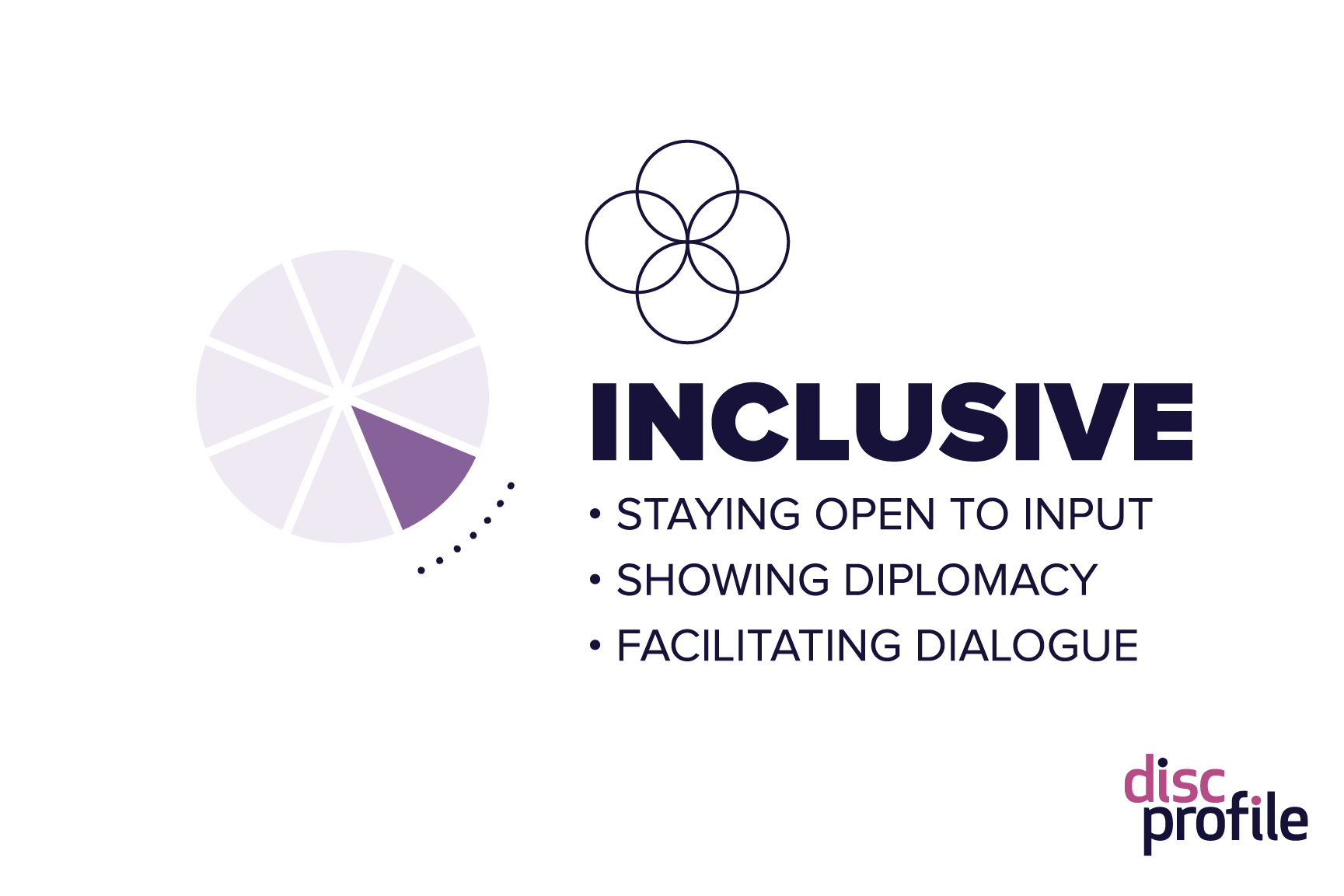Inclusive Leaders: DiSC S Style Leadership
Key Takeaways
- Inclusive leaders align with the S style in the Everything DiSC® model of leadership.
- People with an inclusive leadership style are open to input, diplomatic, and patient when leading.
- Every type of leader can learn from inclusive leaders how to recognize employee contributions, motivate through positivity, and be authentic listeners.
Inclusive leadership is one of the eight types of DiSC leadership. This article will help people with DiSC S styles understand their natural leadership strengths and weaknesses. It will also help leaders of all styles understand how to leverage inclusive leadership when the situation demands it.
The inclusive leadership style
Inclusive leaders are people-oriented, great listeners, and able to tap into the talents and motivations of their teams. They are patient, understanding, soft-spoken, and genuinely interested in others.
You won’t see this leader clawing their way to the top. Their need for status and achievement is lower than most. They might be competitive, but not from a need to be on top. They want to see the group succeed.
If you’re an inclusive leader, you might notice that you have a desire to surround yourself with the familiar. You tend to internalize problems and you have a strong need for harmony. You probably didn’t become a leader to gain status.

Strengths of the inclusive leader:
- They tend to be very people oriented.
- They’re often able to create a warm, safe environment.
- They’re able to overlook other people’s flaws.
- They tend to deliver reliable results.
- They’re often good listeners.
- They tend to be patient.
- They’re willing to make compromises.
- They tend to show appreciation for others’ contributions.
Goals of the inclusive leader:
- Harmony
- Stability
- Acceptance
Areas for improvement:
- Displaying self-confidence
- Revealing true feelings
Source: The 8 Dimensions of Leadership
Jim Kouzes and Barry Posner, The Leadership Challenge
What can we learn from inclusive leaders?
1. You can’t (and didn’t) do it alone
You’re not the only person who has great ideas and works hard. Inclusive leaders know this. They know the importance of recognizing the contributions of others—even those people other leaders might overlook. They understand the importance of the team member in teamwork.
Leaders with inclusive personalities care more about their team succeeding than their own ego needs. They acknowledge even poor ideas in an effort to encourage better ones. As a result, they tend to stimulate better collaboration from their teams.
Lori Beer, JPMorgan Chase
2. People respond to their leader’s words and emotions
I once sat through a presentation with a leader who kept saying reassuring statements all the while shaking his head no. Of course I noticed his negating gesture and distrusted his words. Consciously or unconsciously, followers scrutinize leaders' emotions, gestures, and words.
A leader who displays negative emotions will cause additional stress among colleagues and staff. People expect a certain level of diplomacy from their leaders even when speaking the hard truth. A leader can demand accountability and results without being belligerent. They don’t have to lose their cool to get a point across.
People respond positively to the authentic expression of positive emotions. A leader who shows passion for the projects, the organization, and the people involved can rally others. Showing positive emotions—enthusiasm for a new project, happiness over someone’s good work—can motivate staff.
Larry Bossidy and Ram Charan, Execution: The Discipline of Getting Things Done
3. Really listen, actually listen
For people to listen to you, you have to do your share of the listening. Gaining input from others will improve your decisions. Those who contributed—even if they argued on another side—are more likely to act upon them.
Inclusive leaders are good at facilitating discussions that include everyone and focus on the issue at hand. They are likely to hear information they didn’t know or consider viewpoints and perspectives that make them broaden their own views. This encourages more creative and responsive solutions.
Daniel Goleman, et al., Primal Leadership, Harvard Business Review
Growth opportunities for DiSC S-style leaders
Drive and intensity
Pushing a team to achieve its goals can be difficult for inclusive leaders. They don’t like to feel rushed and don’t want to pressure others. S-type leaders can struggle to model the urgency a team sometimes needs to get immediate results.
Taking risks
A preference for the familiar can keep this type of leader from initiating or embracing change. They are more comfortable with incremental changes that will minimize tension and uncertainty. They prefer to be cautious.
Speaking their mind
Internalizing problems can be an issue for these leaders. They’d rather hold in their frustration than express it and risk upsetting relationships. They never want anyone to feel offended or insulted by them.
Inclusive leaders are slow to anger and uncomfortable with those who get emotional. If they have to fight to be heard, they might choose to be silent, rather than risk appearing overly aggressive.
Making quicker decisions
Inclusive leaders try to find win-win situations and accommodate everyone. Thus, they can be slow to make decisions, especially unpopular or disruptive ones.
Projecting confidence
Leaders with high empathy can have a hard time saying “no.” Inclusive leaders want to appear reasonable and compassionate. Physically, they may assume a posture or use gestures that make them appear smaller or less threatening.
S-style leaders need to be aware that they can come across as indecisive or lacking in confidence. They can work on projecting authority.
Ron Carucci, cofounder and managing partner at Navalent
What is your leadership style?
Everything DiSC Work of Leaders® is a leadership development tool for leaders of all styles and experience levels. You'll discover your DiSC leadership style and how to become a more effective leader in various situations.
Related reading
You can’t (and didn’t) do it alone
- Good Leaders Acknowledge Their Employees Often, International Coaching Federation
- 8 Ways That False Praise Is Ruining Your Team, Thoughtful Leader
- Network effects: How to rebuild social capital and improve corporate performance, McKinsey and Company
People respond to their leader’s words and emotions
- The Key to Inclusive Leadership, Harvard Business Review
- What Inclusive Leaders Sound Like, Harvard Business Review
- 7 Ways Leaders Can Lead When the World Is in Crisis, Inc
- When Negativity Runs High, Practice ‘Deliberate Optimism’, Forbes
Really listen, actually listen
- The Importance of Listening as a Leader in the Digital Era, BetterUp
- The Art of Listening (video), Simon Sinek
- Master Active Listening With These 11 Techniques, Leadership, Leaders Media
Posted 09/16/2013, Last Updated 11/28/2022







